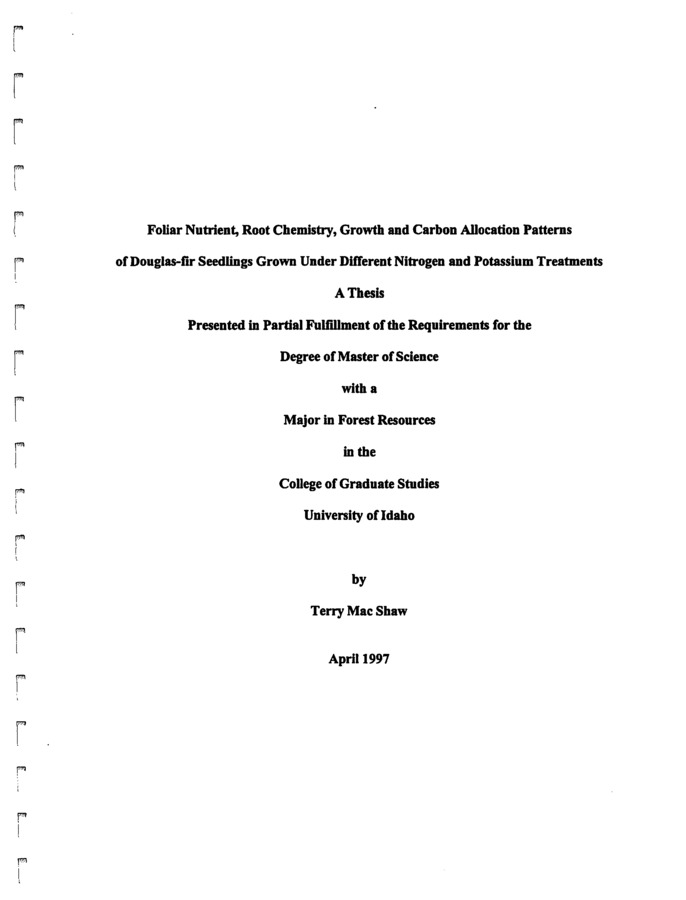PDF
Foliar Nutrient, Root Chemistry, Growth and Carbon Allocation Patterns of Douglas-fir Seedlings Grown Under Different Nitrogen and Potassium Treatments Item Info
- Title:
- Foliar Nutrient, Root Chemistry, Growth and Carbon Allocation Patterns of Douglas-fir Seedlings Grown Under Different Nitrogen and Potassium Treatments
- Creator:
- Shaw, T.M.
- Date Created (ISO Standard):
- 1997-04-01
- Description:
- This research was designed to investigate Douglas-fir seedling nutrition as influenced by four nitrogen and potassium treatments. The results of this study are presented in two sections with these main objectives: 1) to determine the effects of N and K nutrition on Douglas-fir foliar nutrient concentrations, plant growth and carbon allocation patterns; and 2) to determine the effects of nitrogen and potassium nutrition on Douglas-fir root storage and chemical composition. Experimental design and statistical analysis for this experiment were common for both sections of this paper. Results in both sections are based on data taken at the end of a three-year treatment period. Douglas-fir seedlings were randomly assigned to four nitrogen and potassium treatments within two blocks. Treatment effects on growth and plant chemical parameters were estimated by analysis of variance. General linear contrasts and differences between means by treatment for foliar nutrient data, root chemistry and growth parameters were determined by using least-squares means. Results from this study have shown that the N treatments significantly altered foliar nitrogen levels, growth rates and carbon allocation patterns in Douglas-fir seedlings. As expected, total biomass, measured as total dry weight, was threefold higher for seedlings receiving the high nitrogen treatments than for seedlings receiving the low nitrogen treatments. Seedling allocation to needles was the same between the high and low nitrogen treatments, but allocation to roots increased while allocation to stem decreased under low nitrogen supply. Potassium supply had little if any significant effect on growth rates or carbon allocation to stems, roots or needles. This study has shown that the Douglas-fir seedlings adjusted to different nitrogen and potassium treatments by changing carbon allocation patterns. The effects of the nitrogen and potassium treatments on Douglas-fir seedling root production ofsoluble sugar, starch, phenolic and protein-precipitable tannin were observed in this study. Root storage compounds such as starch were reduced in Douglas-fir seedlings receiving the high nitrogen treatments, whereas secondary defensive compounds like phenolics and tannins were reduced in plants receiving low K treatments. Relationships between nitrogen and potassium nutrition lead to storage and secondary compound imbalances.
- Subjects:
- research masters theses fertilizer timber (lumber) statistics
- Source:
- Shaw, T.M. and J.A. Moore, 1997. Foliar nutrients, growth and carbon allocation patterns of Douglas-fir seedlings grown under different nitrogen and potassium treatments. Root chemistry of Douglas-fir seedlings grown under different nitrogen and potassium treatments. M.S. thesis, FWR, Univ. of Idaho, Moscow.
- Source Identifier:
- Foliar_Nutrient_Root_Chem_Growth_C_Allocation_Patterns_DF_Seedlings_Grown_Under_N_and_K_Treatments_M.S.Thesis_1997
- Type:
- Text
- Format:
- application/pdf
Source
- Preferred Citation:
- "Foliar Nutrient, Root Chemistry, Growth and Carbon Allocation Patterns of Douglas-fir Seedlings Grown Under Different Nitrogen and Potassium Treatments", Intermountain Forestry Cooperative, University of Idaho Library Digital Collections, https://www.lib.uidaho.edu/digital/iftnc/items/iftnc4054.html
Rights
- Rights:
- This document is provided by the University of Idaho Library for use by University of Idaho students, staff, and faculty. All rights to the document linked from this metadata belong to the author, rights holder, and/or provider. For more information contact The Intermountain Forestry Cooperative, https://www.uidaho.edu/cnr/ifc
- Standardized Rights:
- http://rightsstatements.org/vocab/InC-EDU/1.0/

